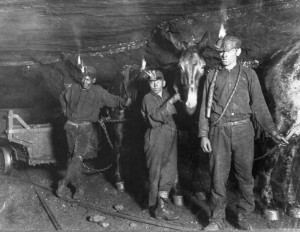
Children, mules and open oil flames: common sights in early coal mines. (Photo via wikipedia.org)
Given the unforgiving environment and physical requirements, coal miners have faced a higher risk of death and injury than other workers in private industries, according to the Bureau of Labor Statistics.
But before there were conveyor belts, extraction machines, hydraulic roof supports, gas detectors, respirators and electric lights – not to mention child labor and animal welfare laws, these workers had to rely on a variety of seemingly outrageous mining safety measures. Here are a few practices from the 1800s and early 1900s that miners used for communication and protection against explosions, suffocation and deadly methane gas.
In many mines, mules replaced women and children in hauling coal. (Photo via wyomingtalesandtrails.com)
1) Canaries and mules
Across America and Europe, animals were relied on to handle the heavy labor and provide an added level of mining safety. The classic example is the “canary in a coal mine.” The birds were basically used as an alert system. Because they are more sensitive to carbon monoxide and other toxic gases, they would get sick before the miners, providing an early sign to get out.
Mules, in a way, were an essential mining safety measure that replaced women and boys in the back-breaking task of hauling baskets of coal to the mine’s main shaft. It wasn’t until 1891 that Congress passed the first federal statute governing mine safety. Among the modest safety requirements, it prohibited operators from employing children younger than 12 – yes, 12.
2) Signal bells
Before telephone systems, a uniform system of elaborate bell signals was used for communication between the hoistmen and workers in the mine. One bell meant “hoist” – or “stop,” if the cage was in motion. Two bells meant “lower,” and three bells meant a man was to be hoisted, so go slow. From there, the signals for water, emergencies and other communications became more complex.
3) Open-flame safety lamps
In the 1800s, miners wore cloth caps – not hard hats – with open oil flames attached for illumination. Meant to increase safety and visibility, these open flames often contributed to fatal hazards, especially when combined with blast mining.
Eventually, mining safety lamps such as the Davy lamp were developed. They provided a flame enclosed in a mesh screen which could not ignite methane and other flammable gases but could signal their presence (by glowing brighter) or indicate low oxygen (by dimming).
4) Rock dusting
According to the Centers for Disease Control and Prevention, explosions accounted for approximately 84 percent of all disaster-related mine deaths from 1911 through 1920. To address the risks of coal dust explosions, given the methane-rich environment, miners began applying a layer of rock dust over the coal dust to create an inert mixture.
5) Shaft-bottom furnaces
Before electric fans became available, early coal mines relied on a furnace placed at the bottom of a shaft. This would create a draft, increase ventilation and reduce the build-up of hazardous gases. This of course also presented the real risk of the fire in the furnace igniting timbers in the mine, which could – and did – consume the oxygen in the mine and suffocate the miners.
6) A “fireman”
An even more horrifying – yet common – method of protecting miners from potential explosions involved sending a “fireman” in before each shift. Dowsed in wet clothes and carrying a candle on the end of a long rod, it was this unfortunate worker’s job to burn out pockets of methane, using the flame. It was often a deadly job.